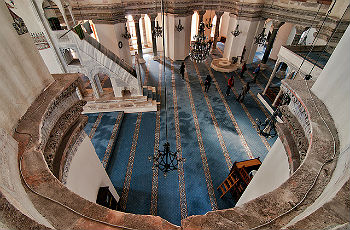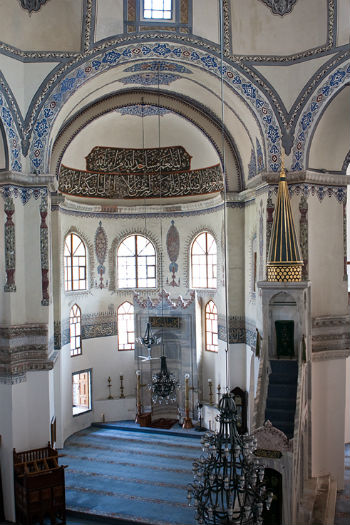Begun in 527 by Emperor Justinian, the Church of Saints Sergius and Bacchus in Istanbul was an early experiment in Byzantine architecture, with a large central dome supported by an octagonal base. The church is now a mosque called Küçük Ayasofya Camii (Little Hagia Sophia Mosque), named for its resemblance to the much larger Hagia Sophia built a few years later.
History
Saints Sergius and Bacchus are Christian Roman soldiers who were martyred in Syria in 303 AD. They became the patron saints of soldiers and their cult was very popular in Syria and beyond.
The Byzantine Emperor Justinian (r. 527-65) was among the saints’ devotees. According to legend, when Justinian was a young man he was condemned to death for plotting against Emperor Anastasius. But Sergius and Bacchus appeared to the emperor in a dream, convincing him to release Justinian.
Justinian began construction on a church dedicated to Sts Sergius and Bacchus immediately after becoming emperor himself in 527 AD; it was completed by 536 AD. The architect was Anthemius of Tralles, a mathematician and the author of a book on burning mirrors, the Paradoxographia. The chosen site was just inside the sea walls west of the Hormisdas Palace (where Justinian lived before ascending the throne), next to the Hippodrome.
The church was connected to a three-aisled basilica dedicated to St. Peter and St. Paul, which Justinian had begun to build in 519. None of it survives today. The Church of Sts. Sergius and Bacchus was built on an octagonal floor plan with a central dome, which inspired the design of the great Hagia Sophia, begun just a few years later in 532. The earlier church was therefore dubbed the Little Ayasofya.
The church was converted into a mosque in the 16th century under Sultan Beyazit II and remains an active mosque today.
What to See
Church of the Saints Sergius and Bacchus is located on the south side of Istanbul next to the Hippodrome; a railway line (near Sirkeci Station) runs between the south wall of the church and sea wall.
The Church of the Saints Sergius and Bacchus interior is decorated and furnished as a mosque, with Arabic calligraphy and designs in blue painted on white walls. Originally, the walls and vault would have been completely covered in golden mosaics, like those that survive from this period in Ravenna, and probably frescoes as well.
The architecture of the building, however, survives fully intact from the Byzantine era. So too does the Greek dedicatory inscription around the central nave:
A fine view of the interior can be had from the gallery stairs are to the right of the entrance.











If you have seen Hagia Sofia, you must also see the first built one. It is smaller yer worth to see.
Great museum and love the preservation they have done. Goes without saying that you need a good camera and wide angle lenses.
Although it was converted into a mosque, the church is intact and well worth the search. Nearby is also the back remnants of the Hippodrome so you can see something interesting that normally isnt on view. The grounds make a nice break from the urban intensity of Istanbul. All round something a little different and off the beaten track.
also called the small aya sofya, this place is in sultanahmet area. no entry ticket to pay just avoid when people are parying on friday cos it can be very crowded but above all u have to respect some strict time of visit
It was under repair (the ceiling) when I visited but, anyways, enjoyed the visit. It's magnificent, every detail is perfection.
They might ask you to leave and come back In between prayer times. So go for a snack, plan a second thing to do instead of visiting a mosque. The sultans palace f e will easily take you several hours because there is so much to see not only the harem 🙂
Lovely 6th century Byzantine church, the building is a mosque now. Great place and well preserved awesome interior. Well worth a visit
Well, everybody knows its bigger relative, the Ayasofya moschee, but this very little moschee is like a small juwel. The small garden with teahouse in front of it, with people playing cards and backgammon, the nice architecture and the peaceful atmosphere really make it a stop worth.
A beautiful, spiritual and historic building.. a little gem compared with some of the larger mosques. Pity about the proximity of the railway.
I found my way to this mosque on my second day in Istanbul after a very unpleasant time at the hotel. I was amazed by the peace and tranquility of this ancient building. Even the railway line which almost clipped the corner did not detract from it.